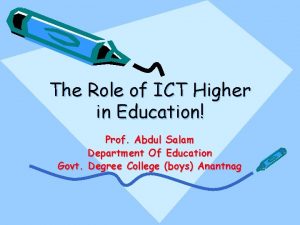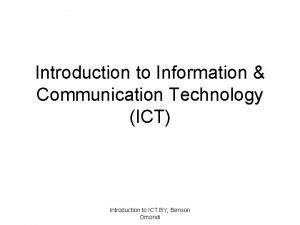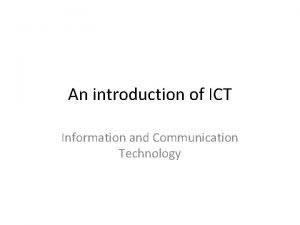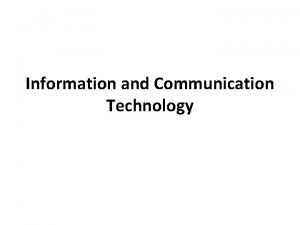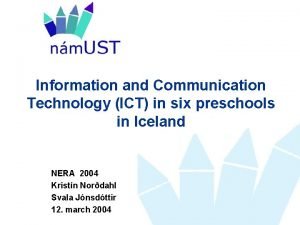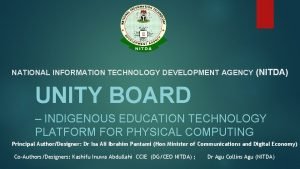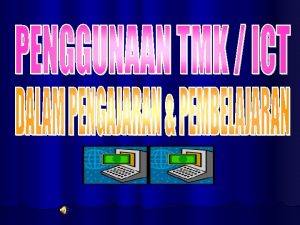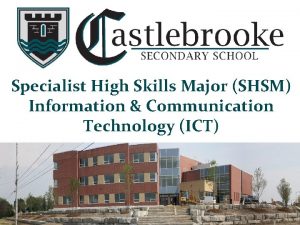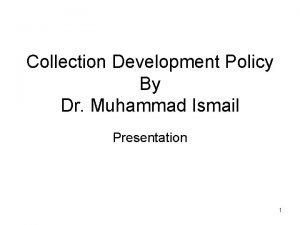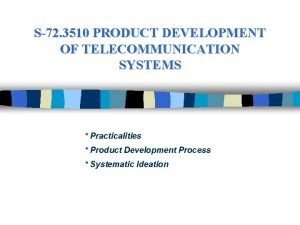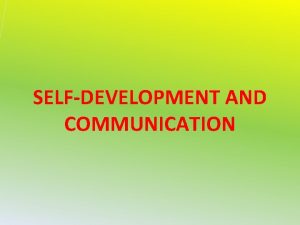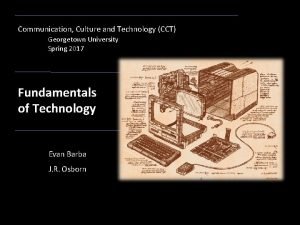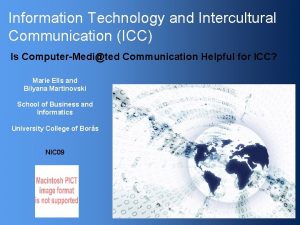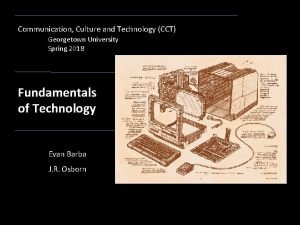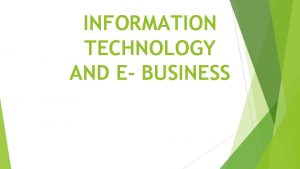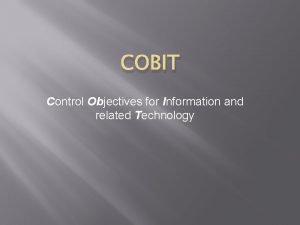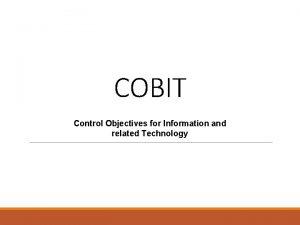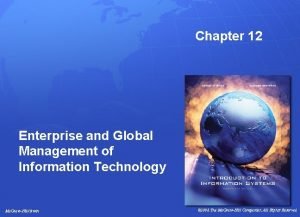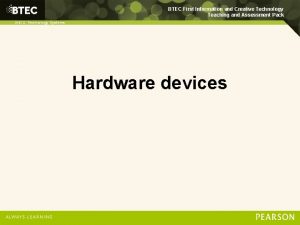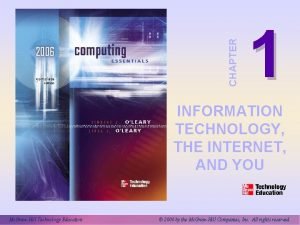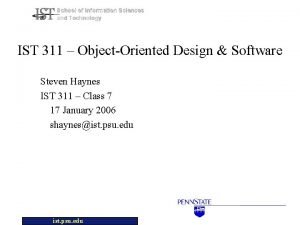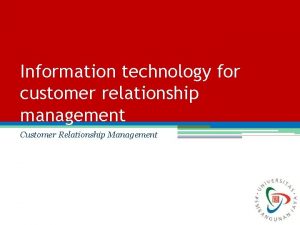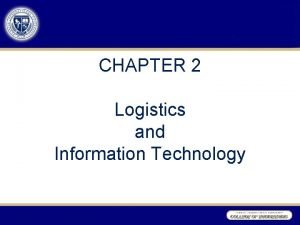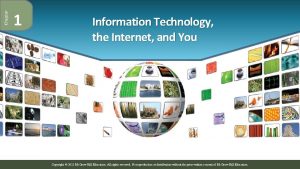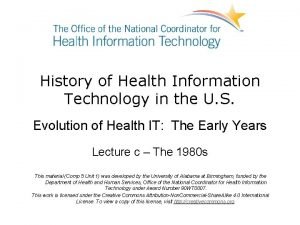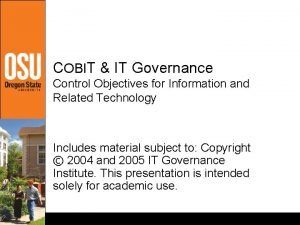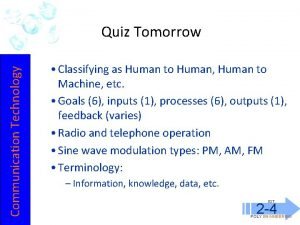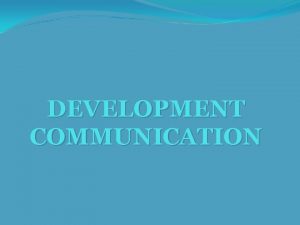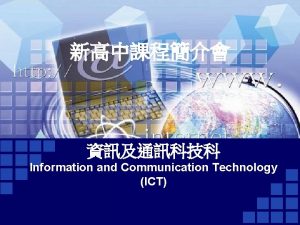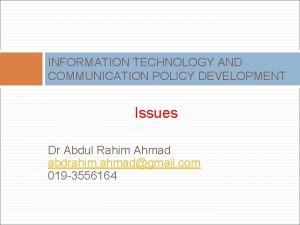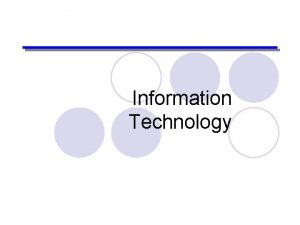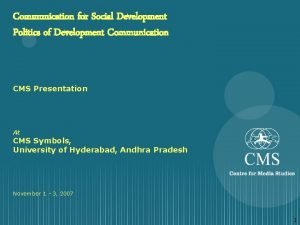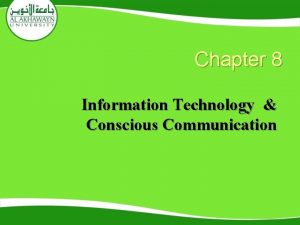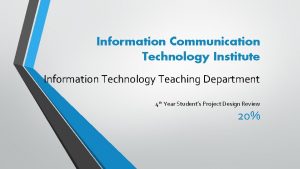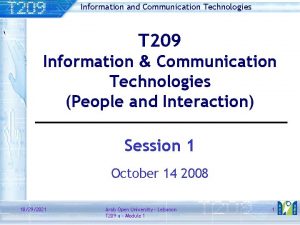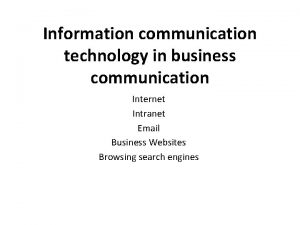INFORMATION TECHNOLOGY AND COMMUNICATION POLICY DEVELOPMENT Information technology



















































- Slides: 51

INFORMATION TECHNOLOGY AND COMMUNICATION POLICY DEVELOPMENT Information technology and society Dr Abdul Rahim Ahmad abdrahim. ahmad@gmail. com 019 -3556164

Summary ICT in Development. Relationship between information technology and society “Technology Determinism Approach” “Social Shaping Technology Approach”

The scope of IT Policy Development Session FUNDAMENTAL CONCEPTS ØTechnology Policy, ICT and ICT Policy ØSocial and Economic Impact of ICT ØDifferent Theoretical Approaches IT POLICY DEVELOPMENT AND INITIATIVES ØDifferent Perspective and Definition ØMotivation, goal, aim and strategies in the formulation and implementation of ICT Policy IMPLEMENTATION OF ITPD IN DIFFERENT COUNTRIES Key motivation, drivers and component of ITPDI in different countries IT Policy Development

WHAT ARE THE ROLES AND IMPLICATIONS OF INFORMATION TECHNOLOGY IN DEVELOPMENT? QUICK RECAP

The Promise of the Information Age • Greater access and availability of information equity • Empower people participate in society actively • Improved Quality of Life • Information and knowledge shared by all • Diversity is acknowledged and celebrated Are these real or virtual promises? Whither the promise? Without ‘em-couragement’, the result is: • Turbulence • Uncertainty • Dis-intermediation of incumbents in government, private sector and community Courage is the will to lead and do IT right!

ICT USES IN DEVELOPMENT • ICT - potent development tool • Has ability to enhance human capability in becoming more productive and contributing members of society – enhances knowledge, skill & values – creates new social & economic development opportunities – promotes effective application of human thinking – integrates human activities – promotes direct participation and democratization

Why Worry About How to Use IT & Knowledge for Development?

Implications for Developing Countries Global environment is increasingly competitive, demanding, & fast changing Need to develop strategies to use existing and new knowledge & IT to: Improve performance in traditional sectors Exploit opportunities for leapfrogging Develop competitive new sectors Need to Learn from other countries Develop strategies for own situation and current context

Role and Implication of ICT in Development Social Dimension Opportunities Democratization of knowledge which leads to empowerment (as well as dis-empowerment) of individuals and society Promotion of learning and literacy as well as the re-establishment of a learning society / knowledge society Rise of the border-less communities that can reinforce traditional values as well as introduce new values

Role and Implication of ICT in Development Economic Dimension Opportunities Intellectual capital joins the ranks of land, labor and traditional capital as factors of economic competitiveness Ability to produce quantum jumps in economic growth and value-addedness Ability to enhance intra-regional trade & globalized trade (S-S & N-S) via e-commerce

Role and Implication of ICT in Development Political Dimension Opportunities Liberalization of marginalized voices / groups Information/knowledge become variables in the power equation next to military and economic might, leading to geo-political shifts in international politics

Should we harness ICT for development? YES! The rise and fall of nations will depend on the ability to master the technology There are no alternate paths in becoming a developed nation Can we effectively harness ICT for development? • Only if the entire nation is mobilized and the national effort is coordinated for maximum impact and leverage

What do we need to watch out for in the process? quality of technological evolution true nature of impact on society (social and cultural) source and degree of control over the technology the effect on organizations and governance structures ability of public policy to respond to the opportunities and challenges posed

The Global Impact of Information and Communications Technology

THE DIGITAL PLANET GLOBAL ICT SPENDING ($US TRILLIONS)

GLOBAL ICT SPENDING BY REGION ($US TRILLIONS)

GLOBAL ICT SPENDING BY TECHNOLOGY ($US TRILLIONS)

ICT Is a Growing Share of U. S. Capital Investment

Nations Rapid Growth In ICT Investment (Annual Growth Rate of ICT Investment, 19932001)

Potentials of IT 20

“It’s the Digital Economy” § § Higher productivity is the key to prosperity. Information Communications and Telecommunications (ICT) has spurred growth in most other nations. (ICT) has been responsible for all the productivity acceleration in the U. S. since 1996. As a result, U. S. annual GDP is $1. 9 trillion larger than it otherwise would be. Spurring digital transformation should be the principal goal of nations’ economic policies.

New “General Purpose Technologies” Drive Change § Most innovations comes in incremental improvements, with modest changes in products and processes. § But approximately every half century a new technology system emerges that impacts virtually everything: § § § what we produce, how we produce it, how we organize and manage production, the location of productive activity, the infrastructure needed, the laws required concerning issues as property rights and permitted forms of business organisation. Since the mid-1990 s ICT has been the engine of change and growth.

General Purpose Technologies Go Through Phases § When the GPT begins life, it is usually in a crude form that is only slowly improved and adapted. § Later in its evolution, when it is becoming well developed, its efficiency rises quickly and its use rapidly and broadly proliferates. § Eventually physical limits are approached, causing gains in efficiency to slow and adoption rates to slow as all available applications are used.

Moore’s Law Has Not Slowed Down (Transistor in Intel Computer Processor Chips)

Moore’s Law Means that Computing Power is Almost Free Microsoft’s free Window’s Live Hotmail email service provides 5 GB of storage for subscribers. It would cost Microsoft almost $100 million for each subscriber if they used 1975 storage technology. (Intel processing costs in $ per MIPS)

Computing Used To Be Scarce

Now IT is Everywhere (70 % of chips don’t go into computers. ) The new John Deere Cotton Harvester : John Deere & Co. CEO Bob Lane says he doesn’t make tractors but rather “sophisticated mobile information factories” • GPS to show where it is. • Microwave sensors to measure the flow of the cotton. • RFID tag inserted into each bundle to let processors know precise origin of the bundle. • Wireless data communications. • The computing power of 8 PC’s.

GPT’s Have 3 Main Characteristics 1. They undergo rapid price declines and performance improvements. 2. They are pervasive. 3. They make it easy to invent and produce new products, processes and business models.

IT Matters To Firms, as Well as Nations IT Adoption Correlates with Firm Productivity and Profits § On average, for every dollar invested in IT, market valuation of a firm rises by over 10$ (Brynjolfsson, Hitt, and Yang, 2002).

Most Nations Have Benefited from ICT § § Japan: From 2000 to 2004 ICT capital had a 5 times larger impact on gross domestic income than did non-ICT capital, and was responsible for 51% of GDP growth, 1995 -2004. (Kanamori and Motohashi, 2007). Within manufacturing, use of ICT causes significant increase in productivity (Motohashi, 2007). Korea: 20 % of Gross Domestic Income from use of ICT from 1995 to 2004 (Kanamori and Motohashi, 2007). China: ICT usage accounted for 38% of the increase in TFP growth and 21% of GDP growth. (Heshmati and Yang, 2006) Australia: Higher computer use associated with higher MFP. Without price declines in computers in the 1990 s, GDP would be 4. 8% less in 2000 (Simon and Wardrop, Reserve Bank of Australia, 2002)

Most Nations Have Benefited from ICT § § § Malaysia: Use of ICT had the largest impact on manufacturing productivity, larger than human capital. (Ahmed, 2006) Hong Kong, Indonesia, South Korea, Malaysia, Philippines, Singapore, Taiwan, and Thailand: ICT use had significant, positive impacts on productivity, GDP growth and overall stock market values from 1991 to 2002 (Feinberg and Tokic). Canada: The major reason for Canada’s lagging productivity growth is its lagging ICT spending per worker, less than half of U. S. levels. (CSLS, 2005) Use of ICT is associated with positive performance in the food processing industry (Baldwin, Sabourin, and Smith, 2004).

Most Nations Have Benefited from ICT § For every 10% of UK employees using personal computers, a firm’s productivity increased 2. 2%; Internet-enabled computers boosted productivity 2. 9%. § Greater ICT investments by French firms led to faster productivity growth. § Without ICT investments Italian productivity growth would have been even slower. § ICT investments boosted growth in Finland, Germany, Netherlands, and Switzerland. § § While EU-4 nations (France, Germany, the Netherlands, and the UK) saw lower acceleration of productivity growth in intensive ICT-using sectors than the U. S. , the sectors still experienced a pick up in growth rates. Nations whose ICT expenditures rose sharply in the 1990 s experienced a pickup in productivity growth. Nations where spending on ICT fell or only grew marginally saw no productivity acceleration.

Key Questions to ponder The Shaping of Information Technology: Determinism or Choice? What are the key determining factors in social development and how much scope is left for human choice? Is social development determined by technology, or is technology a cultural product that is shaped by other cultural factors such as values and political or moral choices? Control and power: Who controls information technology and what power does this bring? Does IT tend to be developed and used for the good of all, increasing individual freedom and reducing inequalities of power and wealth, or does it threaten to have the opposite effect unless checked?

Approaches: Relationship between IT & society Philosophers - “free will” and “determinism” Economist - “demand-pull” and “technologypush” theories of innovation and economic development Sociologist Merits of “technology determinism” versus “social shaping”, or human choice within a socio-cultural context.

Main Approaches: The Technology Determinism Approach Technological determinism (TD) is theory that technology is indeed an independent factor, and that changes in technology cause social change. In its strongest version, theory claims that change in technology is the most important cause of change in society. According to technological determinism, technology impinges on society from outside of society. To technological determinism, the microelectronics and IT revolution, they claim, is causing a new form of society to emerge.

Technological determinism (TD) Technological determinism is the notion that technological development is autonomous of society; it shapes society influences social change focus on the 'effects' of technology on society, its 'impact', its 'implications' and so on. research and policy under TD is to attempt, to understand predict the likely consequences of evolving technologies

Different Perspective Under TD "soft" determinism and "hard" determinism and a continuum of positions in between. There is the determinism that sees information technology as the cause of social change and the determinism that sees information technology as a consequence of social change. There is the type of determinism that sees technological development as following an inevitable, fixed course and the determinism that sees information technology as having a uniformity of 'impact' 'optimistic', 'pessimistic' and 'neutralistic' or "the continuist", the "transformist" and "the structuralist".

The 'Optimistic', the 'Pessimistic' and the 'Neutralistic' The 'optimistic' Believes that technological change as 'progressive' leading to a 'better' society in terms of material benefits, work satisfaction, enhanced freedoms, greater consensus, more leisure time etc. The 'optimist' see the great flexibility and wide choice now available through information technology as the basis for accelerating world-wide economic development and for increasing democratisation, with all being able to benefit from improvements in the standard of living, and from wider choice and opportunities

The 'Optimistic', the 'Pessimistic' and the 'Neutralistic' The Optimistic To them, Information technology will play an increasingly important role in reducing real costs, in changing production methods in the factory or office of the future, in re-shaping competition in many markets, in highlighting alternative organisational possibilities and changing lifestyles The 'optimist' believes that miracles are within reach, that information technology means information, information means culture, and culture means emancipation and democracy.

The 'pessimistic' Sees technology as the factor for the increasing alienation, as more people become unemployable through changes in skills requirements, and domination by the information rich over the information poor Emphasizes the risk involved - rising unemployment, social rigidity, and the vulgarization of life. They see information technology as a victory for the impersonal, repetitive nature of tasks and the elimination of jobs. It would solidity the unwieldiness and the hierarchical nature of organisations, reinforcing the omniscience of those 'in the know' while automizing the others

The 'pessimistic' Those is the 'pessimistic' group predict a society where production is organised to satisfy technical norms rather than human need; they see remote and individualised services replacing human centred services in health and education as computer-based medical diagnosis and computer-run learning programmes replaces doctors and nurses, teachers and lecturers. In short, the pessimistic scenario is one where information technology is manipulated for the benefit of a privileged minority in society, and use to control and further exploit the majority

The 'neutralist' Claim that technology is 'neutral' Technology is politically, culturally and morally neutral, and that is value free The 'neutralist' can be divided into two categories: 'complete neutralist' and 'partial neutralist'. The 'partial neutralist' believes that technology does not cause anything by itself, that it is neutral at the microlevel. The 'complete neutralist' group believe that technology is completely neutral. That it can have many types of effects. To them, our optimism's or pessimism's should be at the level of the organisation.

The 'continuist', the ' transformist' and the 'structuralist' The 'transformist' See information technology as a truly revolutionary technology which will be accompanied by revolutionary changes to society. Adoption of information technology will be swift and the transformation of society on a par with the transition from agricultural to industrial societies. They believe that information technology is likely to speed up value change as it exposes people to new information and, more important, new ways of dealing with information.

The 'continuist' Believe the recent developments in information technology as merely the current stage in a long-term process of incremental change in information processing technology. The rate of diffusion will be slow and society will remain essentially unchanged. In the continuist view, the issues around information technology are similar to those posed by other innovations; they tend to focus on specific information technologies - computers, information services, new media, and so on. New information technology to them have been adopted for familiar reasons, to increase competitiveness, efficiency, productivity, to satisfy consumer aspirations and increase convenience.

The 'structuralist' Who steers in the middle which in many respects fall between these two. Those in this group argued that information technology has the capacity to reshape many institutions of industrial society, but do not totally transform them. The structuralist perspective would agree that the changes of the next decades cannot be extrapolated from the past.

The Social Shaping of Technological Approach SST believes that the technological advances used are not shaped by technical factors, but by social influences that determine both the design and implementation of technology innovations Basic assumption of SSTA is that the relationship between technology and society is genuinely an interaction, a recursive process, 'causes' and 'effect', stand in a complex relationship The SSTA also assumes that social shaping is important, technological change is not governed simply by its own 'internal logic'. To SSTA the factors influencing the rate, directions and specific forms of technical change are social as well as technical

The Social Shaping of Technological Approach SSTA believe that the development of information technology has been shaped by society. To them, factors such as economic cost, profit considerations, world wide and domestic competitions, need for technical progress to enhance national power as in mercantilism and military and state intervention etc. lead to particular technologies, and that is more important than the effects of the technology itself To them, technology is affected at the most profound level by society. Not only has the social context affected the rate and direction of the development of information technology but studies have shown numerous cases where the development of IT have been done drawn from the wider society and where social and political considerations have entered into the process design and the implementation.

The Social Shaping of Technological Approach SSTA started from the observation that technology does not develop as a result of a simple technical rationality but from a range of 'technical' choices are available at every stage in the development and use of technology; and various social, economic, cultural and political factors as well as narrowly 'technical' considerations influence which are selected The issues interested by the SSTA are: what are the social factors that shape technological change? ; to what extent, and how does the kind of society we live in affect the kind of technology we produce? ; and finally what role does society play in shaping technology ?

The Social Shaping of Technological Approach (SSTA) There are eight types of social influence on technological change that have been identified: 1. geographical, 2. environmental and resource factors, 3. scientific advance, 4. pre-existing technology, 5. market processes, 6. industrial relations concerns and other aspects of organisation structures, 7. state institutions and the international system of states, 8. gender division and cultural factors

Ways in which social factors may act in the shaping process of technology Firstly, the social factors influencing selection between available technological capabilities. Secondly, where social factors permitted only one area of 'possible' technological development to be pursued. Thirdly, where social factors created particular 'selection environment' that shape technical development, and Finally, where social models are explicitly embodied in technology

THANK YOU
 Conclusion in ict
Conclusion in ict An act of transmitting messages
An act of transmitting messages Information and communication technology capability
Information and communication technology capability Introduction to ict
Introduction to ict Ict meaning
Ict meaning Components of information and communication technology
Components of information and communication technology Definition information and communication technology
Definition information and communication technology National information technology development agency
National information technology development agency Apa itu ict?
Apa itu ict? Shsm ict
Shsm ict Policy development steps
Policy development steps Collection development policy
Collection development policy Language
Language Xkcd specifications
Xkcd specifications Missoula technology development center
Missoula technology development center Telecoms technology and product development
Telecoms technology and product development Technology development and mechanisation
Technology development and mechanisation Self development in business communication
Self development in business communication Communication and community development
Communication and community development Development communication ppt
Development communication ppt Non governmental organization synonym
Non governmental organization synonym Concept of instructional technology
Concept of instructional technology Georgetown university communication culture and technology
Georgetown university communication culture and technology Technology and intercultural communication
Technology and intercultural communication Georgetown university cct
Georgetown university cct Georgetown university cct
Georgetown university cct What is oral communication and written communication
What is oral communication and written communication Diff between oral and written communication
Diff between oral and written communication Microcontroller communication
Microcontroller communication Venn diagram media information and technology literacy
Venn diagram media information and technology literacy Information technology introduction
Information technology introduction Current future trends of media and information
Current future trends of media and information Cobit control objectives
Cobit control objectives Control objectives for information and related technology
Control objectives for information and related technology Enterprise and global management in mis
Enterprise and global management in mis Btec first engineering teaching and assessment pack
Btec first engineering teaching and assessment pack Accounting information technology and business solutions
Accounting information technology and business solutions Venn diagram of media information and technology literacy
Venn diagram of media information and technology literacy Information processes and technology hsc
Information processes and technology hsc Ministry of electronics and information technology
Ministry of electronics and information technology Latest electronics and information technology in odisha
Latest electronics and information technology in odisha Chapter 1 information technology the internet and you
Chapter 1 information technology the internet and you College of information sciences and technology
College of information sciences and technology Library and information technology association
Library and information technology association Information technology and customer relationship management
Information technology and customer relationship management Logistics and information technology
Logistics and information technology Chapter 1 information technology the internet and you
Chapter 1 information technology the internet and you Prosofit
Prosofit History and evolution of health information technology
History and evolution of health information technology Cobit audit guidelines
Cobit audit guidelines Communication technology quiz
Communication technology quiz People with limited access to media and information
People with limited access to media and information
